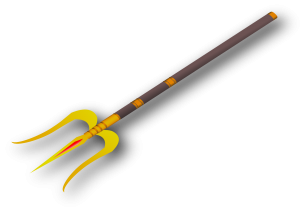
Once, a demon named Murā wanted to kill the Lord, but despite his best efforts, he was unable to do so. However, one day, when Murā noticed that the Lord was taking rest (yoga-nidrā), he saw this as the most opportune moment to kill Him. As Murā approached the Lord, one of the Lord’s potencies appeared from His nose and killed Murā. Since this took place on the eleventh day of the fortnight, that potency of the Lord came to be known as Ekādaśī.
When the Lord awoke, He noticed that Murā was lying dead there while one personality stood nearby [with folded arms]. Upon inquiring about her identity, she submitted, “My Lord! I am Your potency and I appeared to serve You by slaying this demon Murā.” Pleased, the Lord bestowed the following benediction upon her – “You will be known as ‘Ekādaśī’ because you appeared on Ekādaśī tithi and whoever worships you on this day will attain the supreme destination.”
Ekādaśī – The best servant of Hari
There are many types of servants. [Some are considered fallen and some are considered topmost]
Adhama Sevakas
There are many different kinds of adhama (fallen) sevakas; the śāstras mention six types.
alir bāṇo jyotiṣakaḥ
stabdhībhūtaḥ kimekakaḥ
preṣita-preṣakaś caiva
ṣaḍ ete sevakādhamāḥ
[There are six types of unsatisfactory sevakas. They are he who is fickle like a bee (ali); he who talks back, piercing his master like an arrow (bāṇa); the procrastinator (jyotiṣaka); the so-called sevaka who is lazy and inactive (stabdhībhūta); he who refuses to try to do anything on his own (kimekaka); and the so-called sevaka who passes the buck (preṣita-preṣaka).]
One of them is a bāṇa sevaka, who is likened to an arrow; meaning if gurudeva says, “Could I get a cup of water?” he will either respond in a way that hurts gurudeva or he will leave never to return. Because an arrow (bāṇa) has two specialties – it either pierces the target or once released, it cannot be withdrawn. So in the same way, the bāṇa sevaka, upon receiving gurudeva’s instruction, leaves and never returns to fulfil it or replies in such a way that hurts the heart of his gurudeva.
The kimekaka sevaka, upon being requested by gurudeva, “Could I get a cup of water?” immediately retorts saying, “There are so many sevakas around, why do you always order me and not others?”
When a preṣita-preṣaka sevaka is asked by gurudeva, he engages someone else to do that service.
A stabdhībhūtaḥ sevaka becomes confused, stunned or motionless whenever his gurudeva demands anything and therefore he does nothing.
 An ali sevaka only follows gurudeva’s order when it becomes favourable to him. Not otherwise.
An ali sevaka only follows gurudeva’s order when it becomes favourable to him. Not otherwise.
And finally there is the jyotiṣakaḥ sevaka who procrastinates when his gurudeva gives him an order.
[In this way there are different kinds of adhama sevakas.]
Ekātmā sevaka
That sevaka who proactively serves by pre-empting what is required, is known as the topmost sevaka. Such a dedicated sevaka is ekātmā, one with the heart and desire of Śrī Guru, and he does everything to fulfil that desire. He doesn’t wait to act until instructed. He is just like Ekādaśī-devī, who promptly served the Lord [when the need arose] without being ordered and hence she is known as the best servant of Hari.
By the mercy of Ekādaśī, the bhakti residing in her heart gets transferred in the hearts of those who observe this Ekādaśī-vrata. That is why she is known as the mother of bhakti, mādhava-tithi, bhakti-jananī, jatane pālana kori.
— Śrīla Bhakti Vijñāna Bhāratī Mahārāja (www.visuddhacaitanyavani.com)
Image/Art made possible by Pixabay.com








